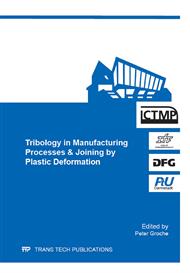[1]
M. Geiger, et al., Microforming, CIRP Annals - Manufacturing Technology, vol. 50, pp.445-462, (2001).
Google Scholar
[2]
U. Engel, Tribology in Microforming, Wear, vol. 260, pp.265-273, (2006).
DOI: 10.1016/j.wear.2005.04.021
Google Scholar
[3]
F. Vollertsen and Z. Hu, Tribological size effect in sheet metal forming measured by a strip drawing test, CIRP Annals, vol. 55, pp.291-294, (2006).
DOI: 10.1016/s0007-8506(07)60419-3
Google Scholar
[4]
M. Taureza, et al., The influence of die geometry and workpiece mechanical properties in T-Shape friction test, Journal of Materials Processing Technology, vol. 212, pp.2413-2423, (2012).
DOI: 10.1016/j.jmatprotec.2012.06.021
Google Scholar
[5]
M. Taureza, et al., On the influence of workpiece material on friction in microforming and lubricant effectiveness, Journal of Materials Processing Technology, vol. In press, (2013).
DOI: 10.1016/j.jmatprotec.2013.11.003
Google Scholar
[6]
S. Schreck and K. H. Zum Gahr, Laser-assisted structuring of ceramic and steel surfaces for improving tribological properties, Applied surface science, vol. 247, pp.616-622, (2005).
DOI: 10.1016/j.apsusc.2005.01.173
Google Scholar
[7]
A. Borghi, et al., Tribological effects of surface texturing on nitriding steel for high-performance engine applications, Wear, vol. 265, pp.1046-1051, (2008).
DOI: 10.1016/j.wear.2008.02.011
Google Scholar
[8]
E. Brinksmeier, et al., Tribological behavior of micro structured surfaces for micro forming tools, International Journal of Machine Tools and Manufacture, vol. 50, pp.425-430, (2010).
DOI: 10.1016/j.ijmachtools.2009.11.006
Google Scholar
[9]
R. S. Eriksen, et al., Manufacture of functional surfaces through combined application of tool manufacturing processes and Robot Assisted Polishing, CIRP Annals - Manufacturing Technology, vol. 61, pp.563-566, (2012).
DOI: 10.1016/j.cirp.2012.03.020
Google Scholar
[10]
K. Wagner, et al., Tool life enhancement in cold forging by locally optimized surfaces, Journal of Materials Processing Technology, vol. 201, pp.2-8, (2008).
DOI: 10.1016/j.jmatprotec.2007.11.152
Google Scholar
[11]
M. Geiger, et al., Excimer Laser Micro Texturing of Cold Forging Tool Surfaces - Influence on Tool Life, CIRP Annals - Manufacturing Technology, vol. 51, pp.231-234, (2002).
DOI: 10.1016/s0007-8506(07)61506-6
Google Scholar
[12]
Y. Uehara, et al., Tribological properties of dimpled silicon nitride under oil lubrication, Journal of the European Ceramic Society, vol. 24, pp.369-373, (2004).
DOI: 10.1016/s0955-2219(03)00220-6
Google Scholar
[13]
M. Wakuda, et al., Effect of surface texturing on friction reduction between ceramic and steel materials under lubricated sliding contact, Wear, vol. 254, pp.356-363, (2003).
DOI: 10.1016/s0043-1648(03)00004-8
Google Scholar
[14]
M. Suh, et al., Effect of geometrical parameters in micro-grooved crosshatch pattern under lubricated sliding friction, Tribology International, vol. 43, pp.1508-1517, (2010).
DOI: 10.1016/j.triboint.2010.02.012
Google Scholar
[15]
M. Wakuda, et al., Effect of surface texturing on friction reduction between ceramic and steel materials lubricated sliding contact, Wear, vol. 254, (2003).
DOI: 10.1016/s0043-1648(03)00004-8
Google Scholar
[16]
X. Wang, et al., The effect of laser texturing of SiC surface on the critical load for the transition of water lubrication mode from hydrodynamic to mixed, Tribology International, vol. 34, pp.703-711, (2001).
DOI: 10.1016/s0301-679x(01)00063-9
Google Scholar
[17]
A. Kovalchenko, et al., The effect of laser surface texturing on transitions in lubrication regimes during unidirectional sliding contact, Tribology International, vol. 38, pp.219-225, (2005).
DOI: 10.1016/j.triboint.2004.08.004
Google Scholar
[18]
N. P. Suh, et al., Control of friction, Wear, vol. 175, pp.151-158, (1994).
Google Scholar
[19]
W. R. D. Wilson, Friction and lubrication in bulk metal-forming processes, Journal of Applied Metalworking, vol. 1, pp.7-19, (1978).
DOI: 10.1007/bf02833955
Google Scholar
[20]
A. Amanov, et al., The influence of bulges produced by laser surface texturing on the sliding friction and wear behavior, Tribology International, vol. 60, pp.216-223, (2013).
DOI: 10.1016/j.triboint.2012.10.018
Google Scholar
[21]
X. Song, et al., Development of low cost deformation-based micro surface texturing system for friction reduction, presented at the ICOMM 2014, Singapore, (2014).
Google Scholar


